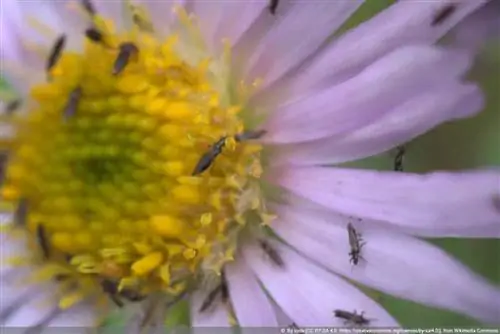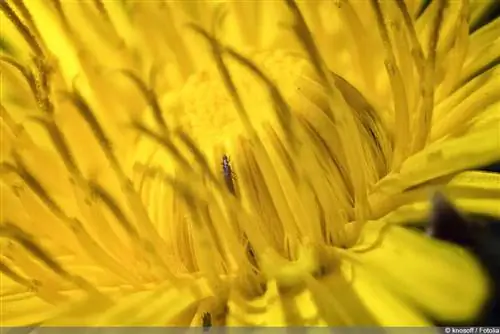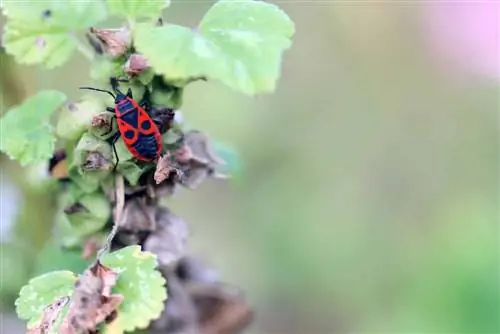- Author admin [email protected].
- Public 2023-12-17 03:39.
- Last modified 2025-01-24 12:45.
When your own plants receive animal visits, it is rarely a reason to be happy. The small winged thrips drill into the cells and gradually suck out the plant sap. Only mottled leaves reveal the well-camouflaged pest. As long as the sap flows, he will not move on voluntarily. So how does the plant get rid of it? What can we contribute?
Appearance and size
The scientific name for this insect is Thysanoptera. The pest is represented in this country by around 200 different species. Although it is widespread and often attacks our plants, the infestation is not immediately noticeable to the untrained eye. The culprit is far too small and inconspicuous for that.
- one to three millimeters long
- dark brown to black coloring
- long, narrow wings
- Wings are frayed
- with black and white stripes
- have a stinging proboscis
- Larvae have no wings
- white to yellowish colored
Despite the beautiful wings, the thrips' flying skills leave a lot to be desired. Instead, they prefer to crawl or simply let the wind carry them around.
malicious image

The thrips pierce the outer cells of the leaves with their proboscis and suck them out completely. The empty cells initially turn yellow, later air penetrates them and they shimmer silvery white. A single leaf cell is microscopic. However, countless damaged cells lying next to each other form a sufficiently large area that the discoloration soon becomes visible to the human eye.
- At first the leaf damage is not visually noticeable
- later the leaf looks mottled and speckled
- the pest droppings also leave traces
- these are little black dots
- If the infestation is severe, leaves dry up and fall off
Frenched winged birds can also spread plant viruses, which in turn damage the plants. Empty cells are not only filled with pure air. Fungal spores can also penetrate the interior of the leaf this way. A severe infestation should therefore not be tolerated for long.
Endangered Plants
The fringed winged birds suck the sap of various types of palm trees and like to attack orchids. Even the cyclamen is not spared from them. If you care for these plant species, you should consciously look out for these pests. If you spot them in time and get rid of them early, they can't cause any major damage. The garden is also a playground for thrips. In addition to flowers and green plants, they also attack vegetables and herbs. The list of endangered plant species is too long to list completely here.
Tip:
When checking your plants, be sure to take a look at the undersides of the leaves. The backs of the leaves are the preferred habitat of the fringed winged winged winged winged winged winged winged winged winged winged winged winged winged wing wing wing wing wing insect.
Isolate affected plant
Isolating is not a control method in itself, but an important step in limiting the infestation locally. Thysanoptera also likes to populate neighboring plants. Preventing this migration makes more sense than starting control work again later.
Shower the plant with water
A fresh shower often works wonders, and not just for us humans. The shower also cleans our plants and washes away what is not wanted on them. Thrips don't have much to counter a hard jet of water. If the infestation is not yet too advanced, you can easily combat the pests using this method.
Spray with soapy water
A particularly gentle home remedy against Thysanoptera is soapy water. This can be made quickly and easily at home. Everything you need can be found in almost every household. How to make the lye and use it professionally:
- Mix 1 liter of water with 2 tablespoons of olive oil.
- Add another splash of dish soap.
- Pour the mixture into an atomizer bottle.
- Spray the soap solution onto the affected plant. The undersides should not be forgotten, as the Thysanoptera likes to hide here.
Tip:
Another recipe for a suitable soap solution consists of a liter of warm water and 15 grams of soft soap, which is dissolved in it.
Stinging nettle broth is effective
Herbs are our allies in fighting pests. Their active ingredients destroy or repel a variety of small insects, including thrips, in a purely natural way. The nettle stands out particularly among the variety of useful herbs. Anyone can make their own nettle broth inexpensively. Here are the instructions for this home remedy:
- Pick about 500 grams of fresh nettle leaves. Alternatively, you can also use 75 grams of dried leaves.
- Put the nettle leaves in a large pot and pour 5 liters of boiling water over them.
- Stir the mixture with a wooden spoon.
- Let the nettle broth steep for 24 hours.
- Spray the affected plant with the undiluted solution.

Tip:
A good portion of freshly pressed garlic can be added immediately before use. This further strengthens the effect and you can get rid of the pests even faster.
Garlic tea for pouring
Garlic does not necessarily have to be combined with nettle stock. This miracle tuber alone has enough suitable active ingredients that it can use against the fringed winged beetle. First, however, a so-called garlic tea must be prepared from the solid garlic bulb. To do this, soak about 150 grams of finely chopped garlic in 2 liters of water for a day. Then add two teaspoons of paraffin. With this home remedy, the plant is watered several times.
Blue adhesive boards attract people
Flying thrips can be easily controlled with adhesive boards. The glue boards should definitely have a blue color, as only these have proven effective in combating winged insects. Yellow boards, on the other hand, are avoided by thrips.
Note:
This control method can only be used as a supplement, as not all thrips have wings. This method is unsuccessful for non-flying specimens.
Fighting larvae with neem oil
Neem oil from the seeds of the tree of the same name is characterized by an insecticidal effect. The active ingredient azadirachtin is responsible for this. It has the power to cause the thrips larvae to die. It is sufficient if the larvae are dabbed with the oil. However, you cannot get rid of adult storm creatures with neem oil. Therefore, this control method should only be used in combination with other methods.
Creating unfavorable living conditions
Thunderstorm animals don't like moisture. They prefer dry and warm air, which is why they prefer to appear in summer and during the winter heating season. Make it difficult for them to survive on your plant by providing more room humidity.
- Spray the plant regularly with water
- Use wide coasters and fill with water
- place the pot elevated to avoid waterlogging
- Place water container near radiator






